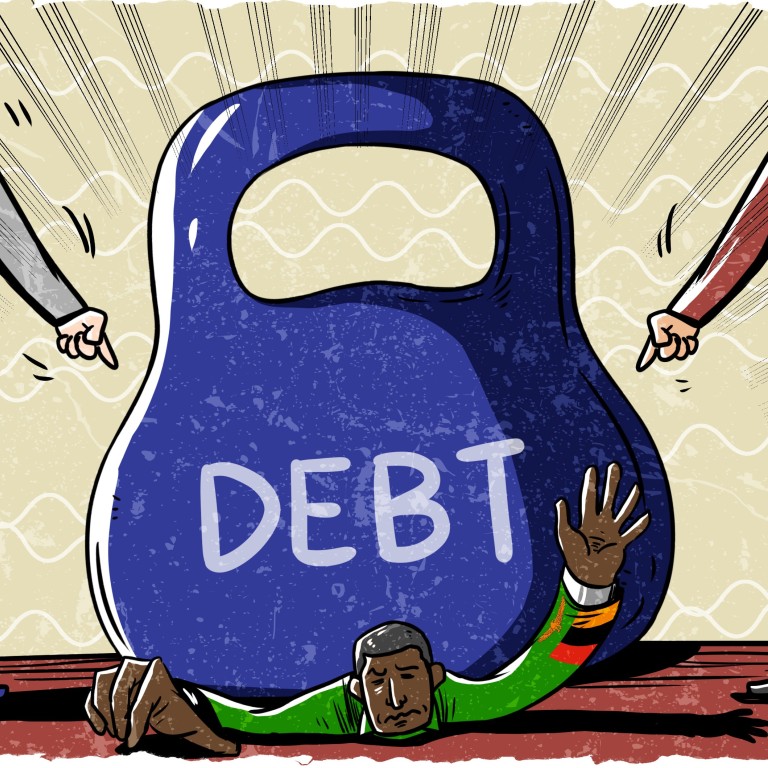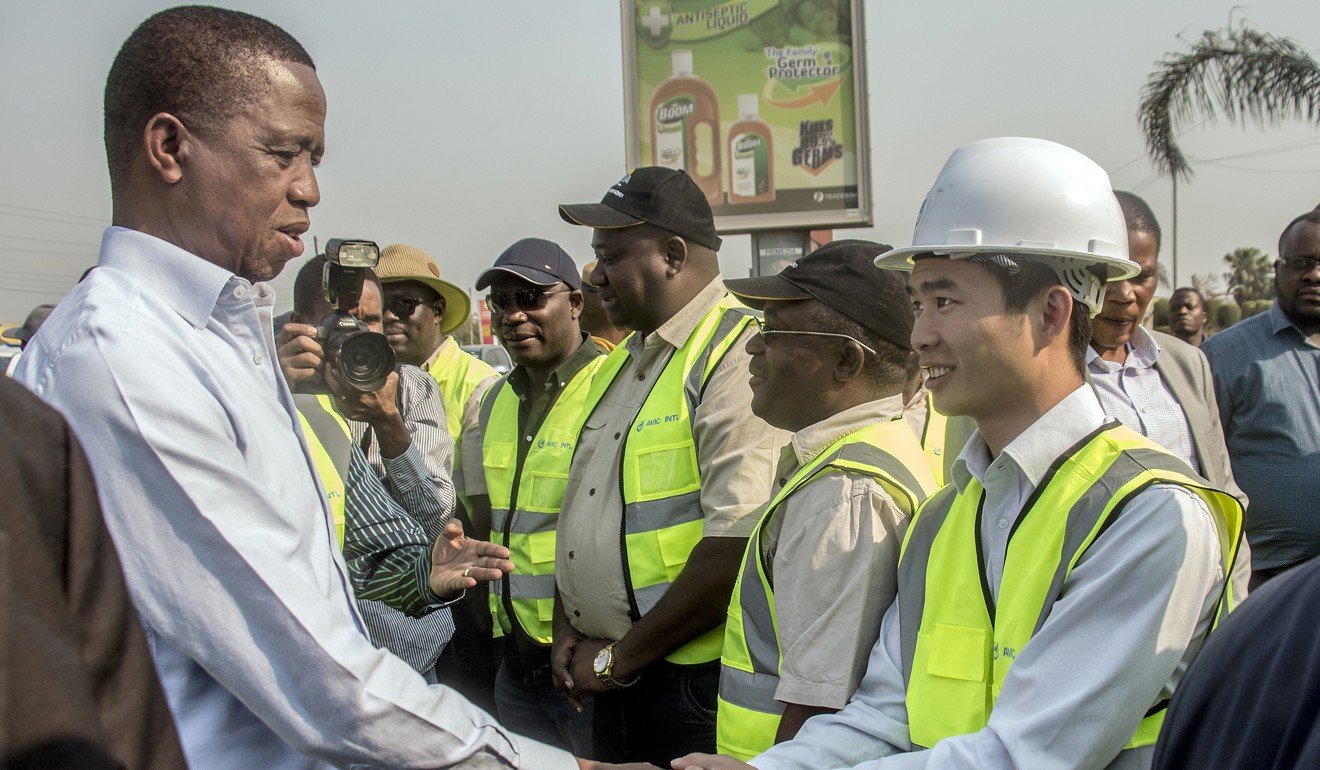
Is a split in the works between Zambia and its long-time business partner, China?
- Lusaka faces a growing debt crisis, and hopes Beijing can help refinance some of its loans so that it can secure new credit from IMF
- Though the countries have a history of projects since to the 1970s, China ‘remains reluctant to engage in formal agreements on debt restructuring’
If there is an African country in which the Chinese have found a home it is Zambia. At the Kenneth Kaunda International Airport in the capital Lusaka, the first billboard that welcomes travellers is one advertising the services of the Bank of China.
Zambia, in south-central Africa, is one of the few countries on the continent where the government-owned Bank of China offers fully fledged banking services in the Chinese currency. Customers can even make deposits and withdrawals in yuan.
The bank has branches in Lusaka and in Kitwe, a town in the Copperbelt region, to serve the growing number of Chinese firms and immigrants living there.
China vows to keep funding African projects despite debt-trap claims
A landlocked nation of some 17 million people, Zambia is said to host one of the largest populations of Chinese expatriates: investors, workers, merchants and farmers. Some sources estimate there are between 80,000 and 100,000 Chinese in Zambia, but the government puts the figure at under 20,000.
Like many other African countries, Zambia, a former British colony rich in copper and cobalt, has embraced China. In return it has received billions of dollars in investments.
Africa’s second-largest copper producer, Zambia was one of the first countries on the continent to receive a major infrastructural investment from Beijing. It took the form of the Tazara railway, which was built by China in the 1970 to links the Copperbelt to Dar es Salaam in Tanzania.
But this five-decade relationship has been put to the test in recent years. Short of critical funds to plug its budget deficit following a slump in the price of copper, which constitutes 70 per cent of its exports, Zambia turned to Beijing for loans.
It borrowed US$6.37 billion between 2000 and 2017, according to the China Africa Research Initiative at the Johns Hopkins School of Advanced International Studies in Washington.
Lusaka used the money, most of which came from China, to expand roads, motorways, bridges, power dams and airports, including an upgrade of Kenneth Kaunda International, named after Zambia’s first president. China Jiangxi Corporation for International and Technical Cooperation was contracted tohandle the project, estimated at US$360 million, partly financed by the Zambian government and Exim Bank of China.
The same company is building the Lusaka-Ndola dual carriageway at a cost of US$1.2 billion with financing from Beijing. AVIC International, another Chinese firm, is building the Copperbelt International Airport, among other big-ticket projects.
Lender’s remorse? China finds Africa projects require debt forgiveness
Zambia also issued Eurobonds worth US$2.8 billion between 2012 and 2015 but now plans to refinance them to cut the cost of debt service. However, with the country’s economic prospects having deteriorated, Fitch Ratings recently downgraded Zambia’s creditworthiness to CCC or junk – meaning there is a very high possibility of debt default.
Fitch estimates that Zambia faces total external debt service repayments of US$2.4 billion (9.9 per cent of its gross domestic product) in 2019. The company said also that Lusaka must prepare to meet the principal repayment on its outstanding Eurobonds due in September 2022 and April 2024.
With the yields on its dollar-denominated bonds topping 20 per cent this year, refinancing will be extremely costly and issuance of additional bonds is not viable, which has sent the country into chaos.
Analysts at Capital Economics, an economic research consultancy in London, said Zambia faced three key economic issues. The first is the country’s large public debt burden.
“Investor concerns about the country’s fiscal situation pushed up yields on the government’s US dollar debt to record highs in May, which have since remained at elevated levels,” said Virág Fórizs, emerging markets economist at Capital Economics.
The second is slower growth in the crucial mining sector, the result of lower copper prices and the Zambian government’s tax dispute with investors. During the first half of 2019, copper production declined by 5.3 per cent and earnings fell by 23.5 per cent. The decrease is attributed mainly to low-ore grade, suspension of some mining operations, operational challenges and depleting ore reserves at old mines.
And third, a persistent drought the past two years has lowered agricultural output and electricity generation.
“The latest official GDP growth projections for 2019 have come around to our long-held view that the economy will expand by just 2 per cent this year,” Fórizs said.

The unbridled uptake of debt, falling copper prices and drought in Zambia that has hurt agricultural production and electricity generation, have sent shock waves in the economy. The situation has been made worse by the failure to secure an aid package from the International Monetary Fund and the delays in having its loans from China restructured, which would include swapping its Chinese debt from dollars to yuan in a bid to ease pressure on foreign reserves, according to Zambian treasury officials.
China holds the key in Zambia’s economic renaissance as Chinese debt restructuring is a condition before it can unlock the US$1.3 billion credit facility from the IMF. Zambia approached the fund for a bailout in 2017 but talks fell through last year when the IMF questioned its heavy borrowing when local revenues could not pay for the loans. Total public and publicly guaranteed debt including arrears at the end of 2018 was 78 per cent of GDP, with the external debt stock at the end of June reported at US$11.5 billion, according to the IMF.
Are Chinese infrastructure loans putting Africa on the debt-trap express?
Zambia owes China more than a third of its foreign debt – about US$4 billion – but critics, including the IMF, believe Lusaka may be hiding the extent of its indebtedness – as happened in neighbouring Mozambique, which in 2016 was forced to admit it had kept secret US$2 billion of borrowing. The IMF’s push for Zambia to put its debt records in good shape caused a major rift, when the IMF was forced to recall its country representative unceremoniously last year.
As a condition to secure the credit facility Zambia sought, the IMF last year demanded that it restructure its loans from China and other foreign lenders. The IMF set similar conditions for the Republic of Congo earlier in the year, helping unlock US$449 million from the IMF in June.
Talks resumed early this year, but Zambia is yet to secure funding from the IMF. With the slump in the price of copper, there is growing fear that it may find it even more difficult to meet its debt obligations.
Fórizs said that despite Zambia’s appointment of a new, IMF-friendly finance minister in July, there had not been much progress on securing a deal. This is probably because Zambian President Edgar Lungu continues to resist the IMF’s policy demands.
Charlie Robertson, global chief economist at Renaissance Capital, said that Zambia’s problems stemmed from fiscal irresponsibility. The budget deficit has been running at 6 to 9 per cent of GDP in recent years.
“Investors have lost faith in government promises to get spending under control and the government has fallen out with the IMF as well,” he said.
For the Beijing bailout, Zambia is seeking a review of loan terms including the extension of the repayment period and probably loan write-off.
“China might be willing to offer some support on the debt front, but it too wants to see credible proposals,” Robertson said.
Jan Friederich, head of Middle East and Africa Sovereign Ratings at Fitch, said there was no progress on the IMF programme.
“Essentially, the IMF and the government still seem to disagree on the appropriate level of fiscal deficits and debt accumulation over the coming years,” he said in an interview. “Specifically, the IMF remains too concerned about debt sustainability in Zambia.”
Further, he said Zambia was keen to renegotiate terms of loans from China, “but we have no visibility on the progress of these negotiations. China is a key source of financing, but it remains reluctant to engage in formal agreements on debt restructuring”.

No one paints the Zambia picture as dire as Lungu, who told parliament earlier this month that “the art of borrowing is the ability to pay back”.
“There is an accumulation of domestic arrears which has not only negatively impacted the operations of suppliers and contractors but also the performance of the financial sector through an increase in non-performing loans,” he said after Chinese state-owned Sinohydro, which was building a power dam, suspended operations indefinitely due to what sources attributed to non-payment for work already completed.
Sinohydro halted work on the Kafue Gorge hydroelectric project because of “difficulties beyond its control”. The dam is being built by a partnership of Sinohydro and the Zambia Electricity Supply Corporation, Zambia’s state-owned power company.
Trade war between US and China follows Huawei to Africa
Analysts at Capital Economics say Lusaka’s dispute with the international mining company Vedanta over Konkola Copper Mines (KCM) has continued to depress investor sentiment.
In May, the Zambian government appointed a liquidator to run KCM – which is 20 per cent owned by Zambia’s state mining company ZCCM and the rest by Vedanta – over the non-payment of US$5.8 billion import duties. China’s Jiangxi Copper Company is said to be in the race to acquire the mine.
Lungu’s administration is anxious and admits that there is trouble as the country falls behind in its payments schedule with most suppliers and contractors.
In the short term, if Zambia does not succeed in securing the IMF credit facility or have China restructure its debt, it will struggle to meet both local and international obligations.
Fórizs said that without securing an IMF-programme or a debt restructuring deal with China, an acute debt crisis could be in the cards – one likely to involve another large depreciation of its currency, the kwacha, another spike in inflation and markedly slower economic growth.
And the US-China trade war might further fuel Zambia’s fire. China is one of the world’s largest consumers of copper, and the IMF said in a report last month that with the slowdown in the Chinese economy, Zambia’s exports would struggle to grow.
“Escalating trade tensions and a slowdown in growth in China could adversely impact copper prices, while the modest recovery anticipated in mining activity in 2020 after a decline in 2019 is subject to uncertainty,” it said.

